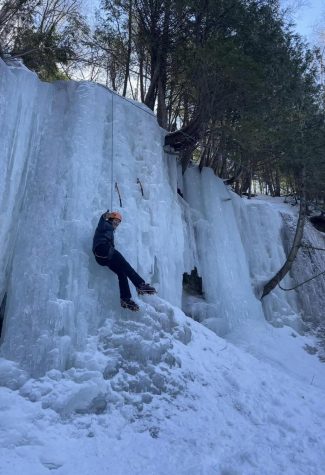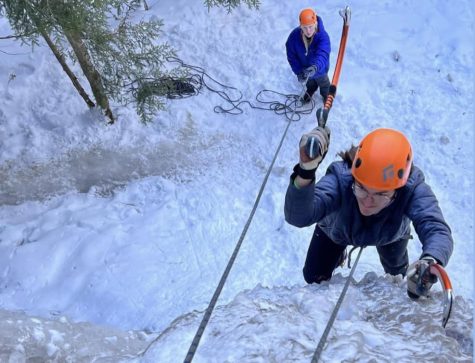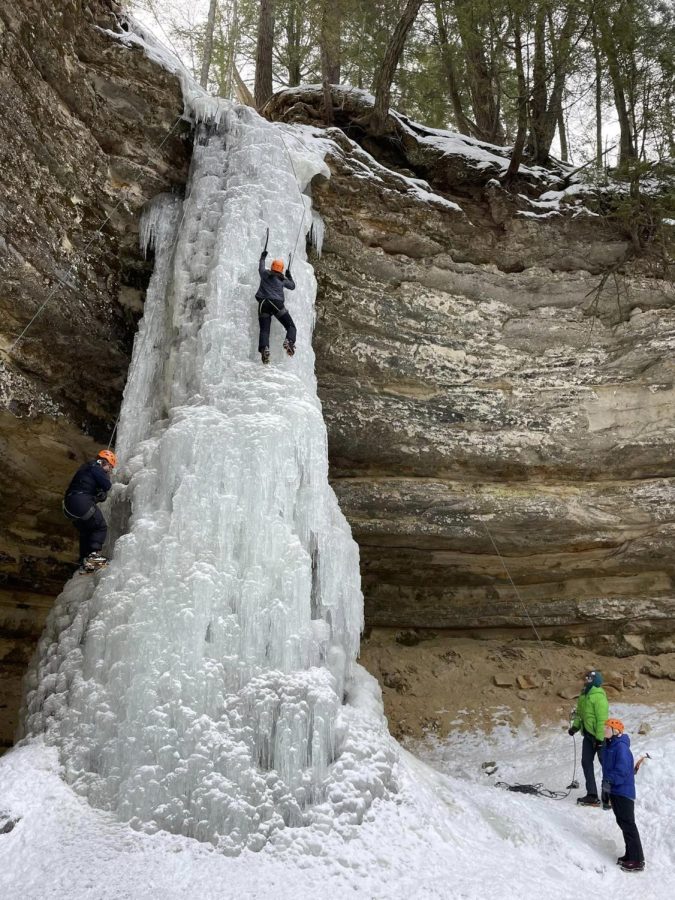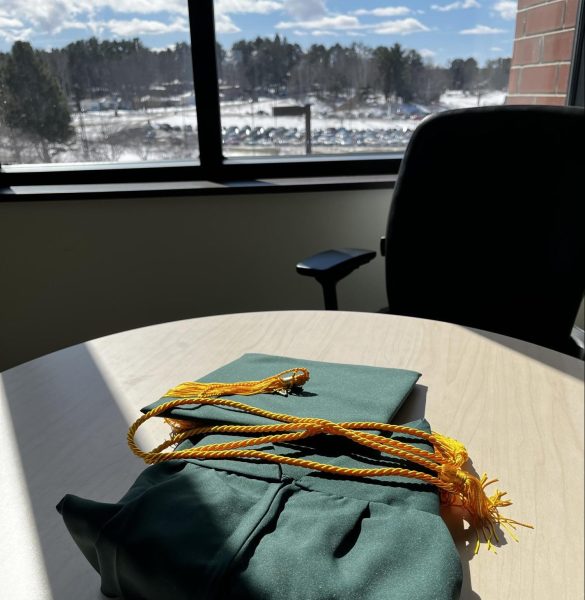Opinion — Ice climbing and the reward of perseverance
CLIMB ON — Despite bruised shins and jelly limbs, I (climbing on the right) reached the top of this 70-foot ice formation — affectionately named “The Dryer Hose” — with several words of encouragement and a few breaks. While physical strength is a must to reach the top, the mental roadblocks were much more complicated to conquer as I clung to the face of the ice.
March 21, 2023
I am the type of person who loves to be challenged. Whether it’s academic, physical or mental trials, I love the process of overcoming hardships because of the great sense of accomplishment that awaits me on the other side.
Due to this drive, I decided to take a three-day ice climbing course at NMU to test myself and possibly walk away with a new favorite sport.
Growing up in the U.P., I have been well aware of Michigan Ice Fest and the beautiful ice formations that are unique to this area. However, I never thought I would be able to participate in the sport because 1) it is incredibly complex, 2) it requires professional guides and advanced equipment and 3) it can be extremely dangerous.
But, when the opportunity presented itself to me, I enrolled in the class with six other students and was soon enough scaling the face of a 70-foot ice formation.
However, our instructors did not just hand us harnesses, ice tools, crampons and a GRIGRI (an assisted braking belay device) and send us on our way. The first day of class was entirely dedicated to understanding the equipment, climbing terminology and technique, along with the safety system being used on the ice.
After three hours of lecturing, we were handed our gear and advised to get a good night’s rest. But just as we were about to walk out the door, our instructor warned us of a phenomenon that is unique to the sport of ice climbing: “the screaming barfies.”
What are “the screaming barfies?” To briefly summarize, your hands and forearms feel like they are being crushed by an anvil, and the pain is so excruciating that it causes you to throw up and cry as you are dangling from the ice.
Awesome. As if I was not worried enough about putting my faith in a bunch of ropes and carabiners, now I had to worry about the possibility that I will scream, cry and projectile vomit in front of my classmates.
But what causes “the screaming barfies?” Picture someone hanging on the face of an ice formation with their hands above their head, gripping their ice tools very tight. In addition to leaning their body up against ice in cold weather, all of the blood is draining downwards from their arms and hands — which causes them to go numb. The technical term for this is “tissue ischemia,” or the diminished flow of blood to soft tissues and muscles.
If a climber’s hands are held above their head for too long and they suddenly release them downward, the return of blood flow to the arms can be incredibly painful. In extreme cases, overstimulation can lead to vomiting.

So, after hiking into our first climb the next morning, my stomach turned as I stared up at the formation. Once the safety system was in place and our instructor hopped on the belay, he asked ‘who’s up?’ In response to his question, I decided to swallow my fear and step up to the rope.
Once strapped into place and with safety checks concluded, I was given the cue to “climb on” and I quietly approached the ice. Everything I had learned yesterday rapidly ran through my mind: sink the right tool, step both feet up, bend knees, extend legs, bring hips in towards the wall, keep heels low, loosen grip and repeat.
Soon enough, I was making good progress on the ice, eager to reach the top. However, I forgot the most vital aspect of the entire climbing process: shaking out my hands. The lack of trust I had in my crampons prevented me from removing my hands from my ice tools, and I soon lost all feeling in my arms.
I started shaking my arms violently as my instructor supported me on the belay device. He yelled up to me ‘you alright?’ as I was overcome by nausea. I responded with ‘I think I’ll come down now’ and he slowly lowered me to the ground. I wobbled over to my pack as I tried to fight off what I thought to be the early signs of “the screaming barfies.”
Thankfully, I did not go through that physical torment, but I was upset that I did not finish the climb. I anticipated scaling the ice to be physically hard — and it was — but the mental challenges I encountered while hanging high in the air were much more difficult to combat than any fatigue.
But after seeing a few of my classmates reach the top, I was more determined than ever to conquer the ice. Upon approaching the rope again, I looked my instructor dead in the eye and said, “Do not let me quit.”
He happily obliged.
Whenever I find myself in tough scenarios, I always like to have something or someone encouraging me to push on. Our bodies are so much stronger than our minds think they are, and we often need that reminder when facing intense situations. Even though our mind is telling us we have hit our physical limit, our bodies have more than enough strength and energy to carry on.
So, with several breaks and great encouragement from my peers and instructor, I was able to scale several ice formations over the two-day period.

Was it challenging? Yes. Did I fail sometimes? Absolutely. But when I finally did reach the top and let out an exasperated yell as my friends congratulated me 70 feet below, no level of exhaustion could beat that feeling of triumph.
That is why I love challenges. I love the sense of accomplishment that accompanies the hard work of perseverance. While ice climbing certainly exacerbated all of those feelings, that only made it much more rewarding — and I cannot wait to get back on the ice.
Editor’s Note: The North Wind is committed to offering a free and open public forum of ideas, publishing a wide range of viewpoints to accurately represent the NMU student body. This is a staff column, written by an employee of the North Wind. As such, it expresses the personal opinions of the individual writer, and does not necessarily reflect the position of the North Wind Editorial Board.































